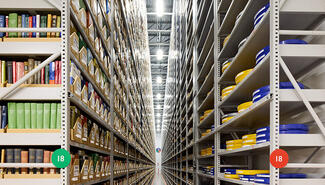Then and now: Beinecke Rare Book and Manuscript Library turns 60 this October
On October 14, 1963, the Beinecke Rare Book and Manuscript Library opened to the public and soon became, just as the benefactors intended, a “source of learning and an inspiration to all who enter.” This year, the staff celebrates the Beinecke Library’s 60 years as part of Yale University Library. Explore the then-and-now photos with the embedded slider on the images below.
The Beinecke Library is one of the largest buildings in the world devoted entirely to rare books and manuscripts. With its freestanding six-story glass tower at center and two floors of underground stacks, it holds more than one million objects: books, manuscripts, maps, ephemera, photographs, posters, paintings, papyri, art objects, and audiovisual and born-digital materials. The library is an important repository for scholars and researchers. Millions of additional materials in the collection are stored nearby at Yale University’s Library Shelving Facility in Hamden.
The building was constructed from 1960 to 1963, the work of a team of notable collaborators. The architect was the Pritzker Prize–winning modernist Gordon Bunshaft of the firm Skidmore, Owings & Merrill. Bunshaft was also one of the designers of the innovative glass-and-steel Lever House in Manhattan, now on the National Register of Historic Places.
Paul Weidlinger of Weidlinger Associates—one-time apprentice to Le Corbusier and collaborator with Bauhaus pioneers Marcel Breuer and Walter Gropius—was the structural engineer.
The George A. Fuller Construction Company was the general contractor. Named for its founder, the “father of the skyscraper,” the company had built the triangular Flatiron Building, one of New York’s first steel-skeleton buildings and the company’s early headquarters.
The iconic structure’s windowless facade is a grid of gray-veined panes of Vermont Montclair Danby marble. The thin, octagonal panes are set in a framework of steel trusses covered with gray granite from Woodbury, Vermont. In daytime, the translucent panes cast soft light throughout the interior, filtering the ultraviolet rays that can damage rare and fragile materials on display. In the evenings, the exterior is illuminated with interior light.
Bunshaft, who had worked with sculptor Isamu Noguchi on other projects, invited the artist to collaborate on this one, “a challenge I wanted by all means to be equal to,” Noguchi wrote in his notes for the model. The Beinecke Library opens onto a sunken courtyard that contains Noguchi’s installation, made with white Imperial Danby marble. The three-piece “landscape”—containing a circle, pyramid, and cube— references the sun, the earth, and chance.

The Beinecke Library and its endowment were the gift of Yale graduates and brothers Edwin John Beinecke, 1907; Frederick William Beinecke, 1909; Walter Beinecke, 1910; and their families.
As noted in “A Statement by the Architects,” published in a 1974 edition of The Yale University Library Gazette, “The famous Yale collection of rare books and manuscripts comprises a history of man’s writings and printings from the oldest known documents to the works of the most modern writers. To house this important collection and to provide space for future acquisitions the Beinecke family have given to Yale a new library building, the Beinecke Rare Book and Manuscript Library,” the authors wrote. “And, we hope we have dramatized the importance of this collection in a building that is in the heart of the Yale campus.”
Each year thousands of visitors come from around the world to attend the many exhibitions and events held within the impressive structure on Beinecke Plaza. The plaza is paved with the same Woodbury granite used in the building.
Read more about the history and architecture of Beinecke Library.
See more than 500 photographs of the construction work in progress.
Watch a timelapse video of the construction of Beinecke Library.
—Deborah Cannarella
Archival still and slider images by C. T. Alburtus and unknown photographers. Images of Isamu Noguchi and the Sunken Garden: (at left) The Noguchi Museum Archives, 04356. Photo: Vytas Valaitas, 1964. ©The Isamu Noguchi Foundation and Garden Museum, New York / ARS; (at right) The Noguchi Museum Archives, 01897. Photo: Ezra Stoller. ©ESTO / The Isamu Noguchi Foundation and Garden Museum, New York / ARS



